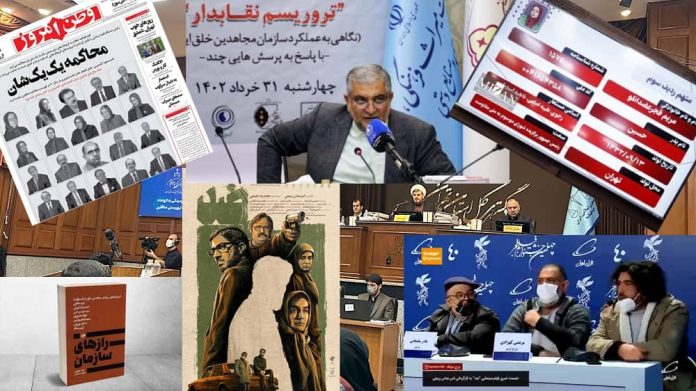Questioning Iran’s Obsession: The MEK’s Rise as a National Movement

Written by
Mehdi Oghbai
iran regime demonization mek propaganda
Three-minute read
On March 25, the state-run Shohaday-e Iran website, linked to the regime’s Ministry of Intelligence and Security (MOIS), republished a letter by the Iranian regime’s founder, Ruhollah Khomeini, to his then-successor, Hossain-Ali Montazeri 35 years ago. But why?
Montazeri once hailed as “the hope of Imam [Khomeini] and Umma [people]” was abruptly dismissed by Khomeini, following his objection to the 1988 massacre of over 30,000 political prisoners. Most of the victims of this massacre which started following Khomeini’s fatwa, were members and supporters of the People’s Mojahedin Organization of Iran (PMOI/MEK).
In his letter to Montazeri, now republished by a MOIS-linked website, Khomeini wrote, “Since it is evident to me that you intend to relinquish control of our country, our cherished Islamic revolution, and the Iranian Muslim people to liberal factions, ultimately leading to the empowerment of the hypocrites [regime’s pejorative expression to defame the Mojahedin-e Khalq Organization], you are no longer eligible to succeed me as the legitimate leader of the state. You, in most of your letters, speeches, and stances, have shown that you believe the liberals and hypocrites should rule this country.”
In his letter to Khomeini, Montazeri called out the massacre, urging for its immediate halt. In a meeting with the so-called “Death Committee,” tasked by Khomeini to carry out the genocide, Montazeri said, “In my opinion, the greatest crime committed under the Islamic Republic, from the beginning of the Revolution until now, is this crime committed by you. And you will be judged by history.”
“Killing is the wrong way to resist against a thought, an idea… They have one thought, one idea. Responding to a process, a logic, even a faulty logic, with killing will solve nothing. It will make it worse, and spread it,” he added.
Nearly forty years on, the murderous regime frantically employs every tactic to stifle the dissemination of MEK’s revolutionary vision: overthrowing the regime and establishing a secular, democratic, and non-nuclear republic.
#Iran’s Regime Admits Failure in 44-Year Effort to Discredit #MEKhttps://t.co/rgxK3iXWrE
— NCRI-FAC (@iran_policy) January 29, 2024
For decades, Iran’s regime and its apologists have sought to vilify the MEK, painting it as a marginal group devoid of support within Iran. Yet Tehran’s continuous push to undermine and obliterate the Iranian Resistance sharply contradicts this falsehood.
In recent months, the Iranian regime launched a farcical trial of 104 members of the MEK and its parent coalition, the National Council of Resistance of Iran (NCRI). This mockery of justice unfolds three decades after Khomeini’s brutal mass executions of MEK supporters and members.
Over the past four decades, the Iranian regime has perpetrated numerous terrorist acts against the Iranian Resistance abroad, while over 120,000 martyrs have sacrificed their lives for the cause of freedom within Iran.
From financing and producing hundreds of films and documentaries to publishing more than 600 books, Tehran has spared no expense in its efforts to demonize the MEK. Utilizing a vast network of “friendly journalists” and apologists in Western media, the regime has deployed substantial resources to tarnish the image of the MEK.
On May 7, 2023, the group “Ghiam ta Sarnegouni” seized control of 210 websites, applications, and databases belonging to Iran’s Ministry of Foreign Affairs (MFA), extracting tens of thousands of documents. Among the revelations were strategic talks between MFA and Ministry of Intelligence and Security officials, focusing on discrediting the MEK.
One document highlights the Supreme National Security Council’s role in assigning MOIS to lead efforts against the MEK, shedding light on the regime’s demonization campaign.
The document shows the regime took the following steps against the MEK:
– Utilize NGOs, human rights associations, and foreign media resources for cultural engagement against the MEK.
– Employ social media platforms and those expelled from the organization for effective propaganda.
– Leverage artistic mediums like cinema for demonization.
– Utilize capacities abroad including the United Nations, NGOs, and international organizations.
– Manage available space effectively for diplomatic efforts to undermine the organization.
– Employ psychological operations and raise awareness of the costs of hosting the MEK.
– Pursue legal proceedings against the organization in European countries.
Hence, these actions prompt a critical question: Why does the Iranian regime invest such extensive time and effort against a supposedly insignificant “fringe grouplet”? Why does the Shohaday-e Iran website feel the need to remind the regime’s forces about Montazeri’s fate and Khomeini’s letter to him?
The answer lies within Iranian society, where the MEK’s long-standing advocacy for regime change has evolved into a national imperative.
Despite the regime’s crackdown post-2022 uprising, defiant youths targeted oppression centers and IRGC bases, totaling roughly 3,006 incidents. MEK Resistance Units carried out 27,726 activities nationwide, including displaying images of Resistance leaders and writing messages in graffiti encouraging resistance. These actions have instilled deep fear in regime officials despite their extensive surveillance.

